Research
17 Postdoctoral Research Teams Mentored as SECA Project Winds up
Published
2 years agoon
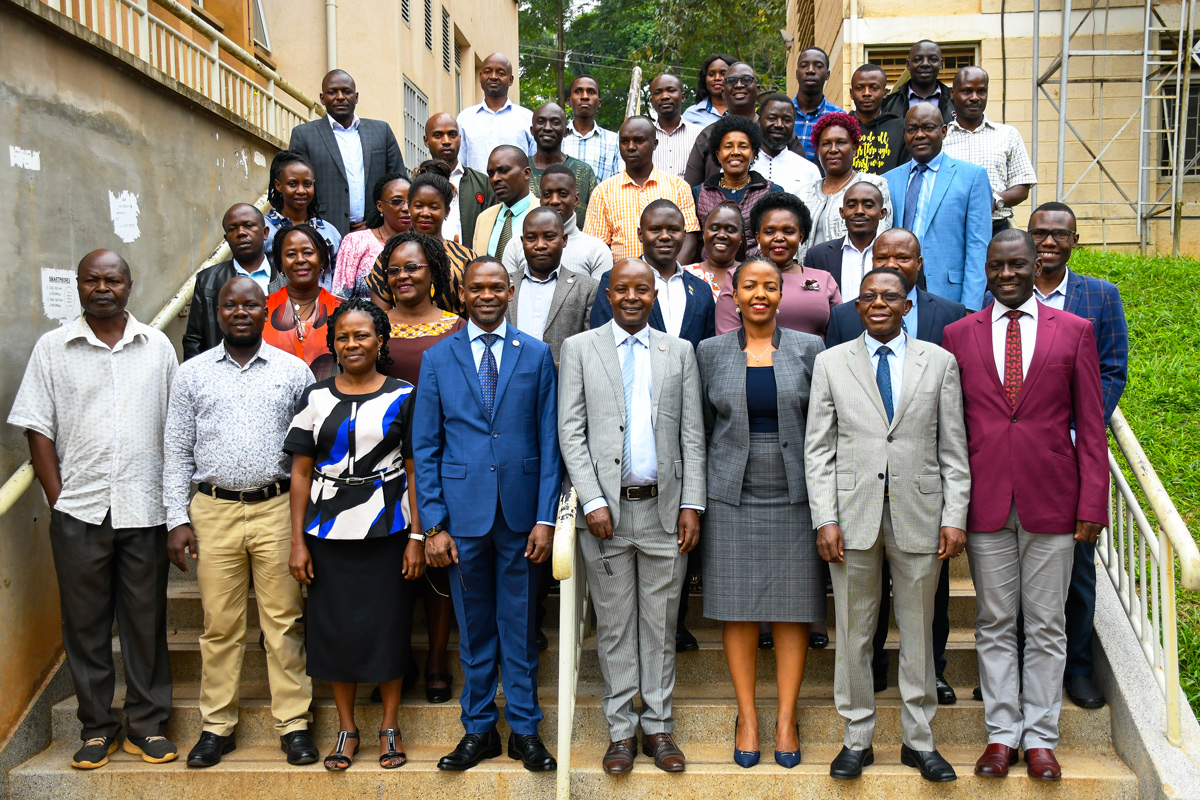
SECA is an acronym for the Supporting Early-Career Academics Programme at Makerere University (2019-2022). SECA is the fifth “phase” of the Carnegie Corporation of New York (CCNY)’s support to Makerere, and follows in the steps of similar successful initiatives that date back to 1946 when the Corporation’s relations with Uganda started. On Thursday 12th January 2023, the Deputy Vice Chancellor (Academic Affairs) and SECA Chairman Project Implementation Committee (PIC), Prof. Umar Kakumba was joined by the Director, Directorate of Research and Graduate Training (DRGT), Prof. Edward Bbaale as well as Academic Registrar and SECA Project Coordinator, Prof. Buyinza Mukadasi to preside over the programme’s final dissemination workshop.
Held in the Telepresence Centre, Senate Building, the workshop accorded the opportunity to research teams to present and discuss their findings. SECA supported seventeen (17) Early-Career academics at Makerere University, eight (8) of whom were female and nine (9) male, to undertake postdoctoral research fellowships in their respective fields of specialty. Additionally, SECA supported professional skills enhancement courses, as well as tuition and research costs for seventeen (17) Masters students (7 female, 10 male) attached to the research teams.
Furthermore, SECA provided funds to fellows for writing and publication, supported mentorship and research team building, provided travel grants to international conferences, and supported fellows to disseminate their findings to academia, policy makers and the general public. To facilitate improvements in the university research environment, SECA provided access to a grant worth US$6,000 to each of the fellows’ host departments. Some of the activities undertaken using the grants included; conducting academic writing and dissemination workshops, holding symposia for PhD students and academic staff, development of academic programmes, renovating research infrastructure and acquiring equipment.
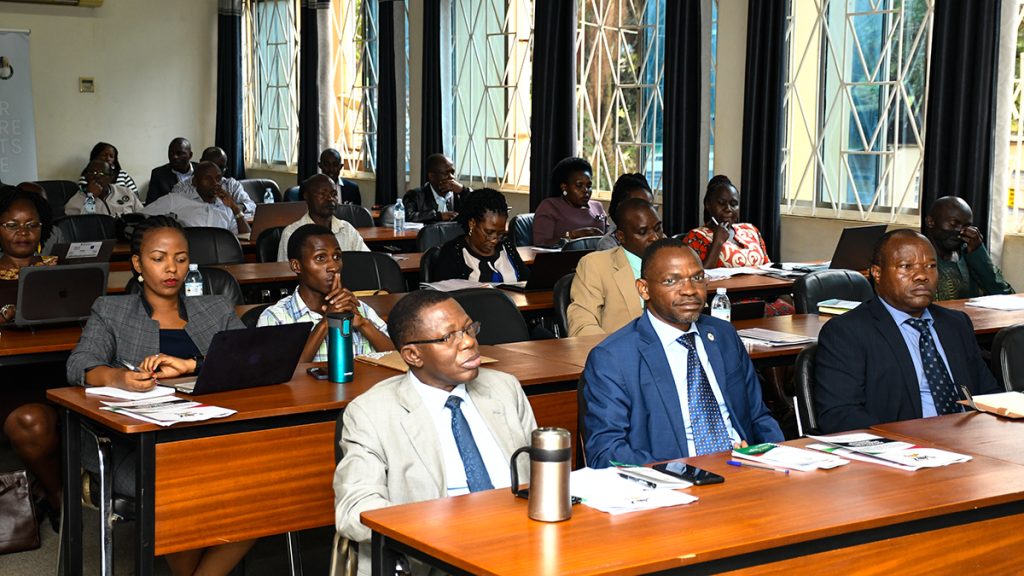
Delivering his remarks, Prof. Umar Kakumba congratulated both Prof. Buyinza and Prof. Bbaale upon their new appointments as Academic Registrar and Director DRGT respectively, and thanked them for contributing to SECA’s success. In the same breath, he recognized and introduced members of the PIC namely; Prof. Jesca Nakavuma, Prof. Nicholas Kiggundu, Dr. Pamela Khanakwa, Prof. Julius Kikooma and Dr. Euzobia Baine Mugisha and thanked them for the rigorous work done in reviewing applications by fellows.
“I wish to congratulate you the fellows. As part of the monitoring team for SECA, we visited what you were involved in and I must say that Makerere has great potential. We received close to 102 proposals, and selecting seventeen (17) was a huge task because every proposition was bankable and attuned to the relevance of our country” Prof. Kakumba remarked.
The DVCAA noted that all projects undertaken by fellows had the potential to co-create knowledge with the communities and respective sectors beyond SECA funding. He therefore called upon them to continue providing research leadership in their departments and communities. On this note, he appreciated the fellows for each mentoring a graduate student.
Prof. Kakumba equally acknowledged CCNY for the generous support accorded to Makerere and continually entrusting the University with various opportunities to enhance the research capacities of her staff. In this regard, he thanked the Mentors, Heads of Department and the PIC for ensuring that the fellows continued to perform well and compile their progressive reports on time. This feat, he acknowledged, has led to Makerere University securing a successor grant in line with SECA.
Addressing the fellows and audience, Prof. Bbaale paid tribute to his predecessor, Prof. Buyinza for his visionary leadership of DRGT that gave rise to initiatives such as SECA. “It is gratifying and heartwarming to have events of this nature that are in line with the research-led agenda of the University.
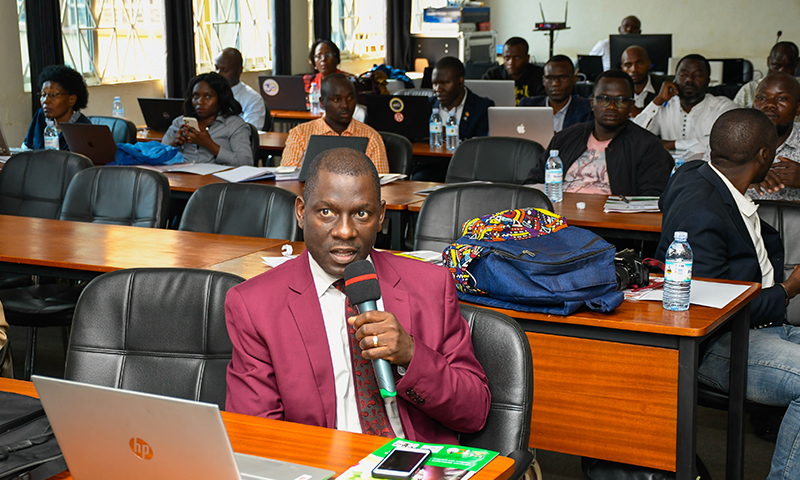
“Postdoctoral research is high quality research, which can go a long way in informing policy for societal transformation. We greatly value each of the projects you have undertaken and we are confident that they have the potential to contribute to the national development agenda. Therefore, we must bring on board targeted dissemination beyond this general dissemination” said Prof. Bbaale.
He explained that targeted dissemination is the gateway to different institutions of Government that are either users or potential users of policy recommendations and different projects that need to be scaled up across the country. Beyond SECA, Prof. Bbaale urged the fellows to form a cluster of researchers as a platform for continued collaboration and a multidisciplinary entity to compete for research grants.
“The world over, postdoctoral research is an engine that must propel the university into a research-led direction… As DRGT, we are soon going to propose a policy on postdoctoral degrees that will pave the way for different units to admit many more postdoctoral fellows” added Prof. Bbaale.
“Makerere’s strategic thinking in terms of research is informed by the Sustainable Development Goals (SDGs), National Vision 2040, African Charter 2063 and the Institutional Research Framework, which implies that we are running a coherent research agenda” said Prof. Buyinza as he commenced his remarks.
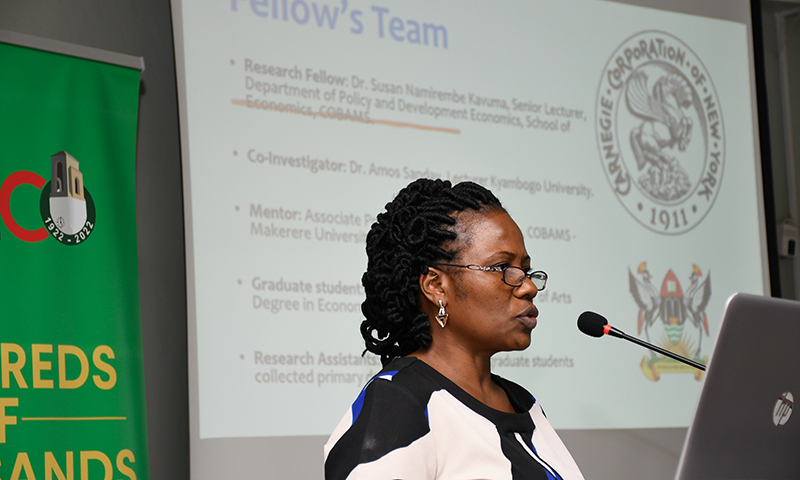
The Academic Registrar added that the realization of these aspirations is dependent on grooming a crop of critical thinkers who can contribute to the knowledge economy. He therefore expressed his gratitude at being able to participate in a number of phases of CCCNY’s support to Makerere, aimed at achieving this objective.
“I have been privileged to participate in the Next Generation of African Academics I, Next Generation of African Academics II, Nurturing Emerging Research Leaders through Post-Doctoral Training (NERLP) and Supporting Early-Career Academics (SECA), which we are closing today, and the successor consolidating the Supporting Early-Career Academics (SECA) programme” he explained.
Turning to SECA, Prof. Buyinza noted that the project was designed to expand Makerere’s community of research leaders and doctoral supervisors through four (4) specific objectives. These included;
- To consolidate the capacity of fellows to conduct quality research with appropriate mentorship at Makerere,
- To strengthen the enabling environment to encourage the retention of fellows at Makerere,
- To strengthen research management and research leadership capacity at Makerere, and
- To increase the capacity for scientific communication of research outputs into publicly accessible writing.
“We believe that we have built an integrated, institutionalized, research mentorship culture at this University because of our model of delivery of this project. It is a three-tier model consisting of the Senior who is the Mentor, the PI (Principal Investigator) who is the Early-Career fellow and the Masters student” said Prof. Buyinza.
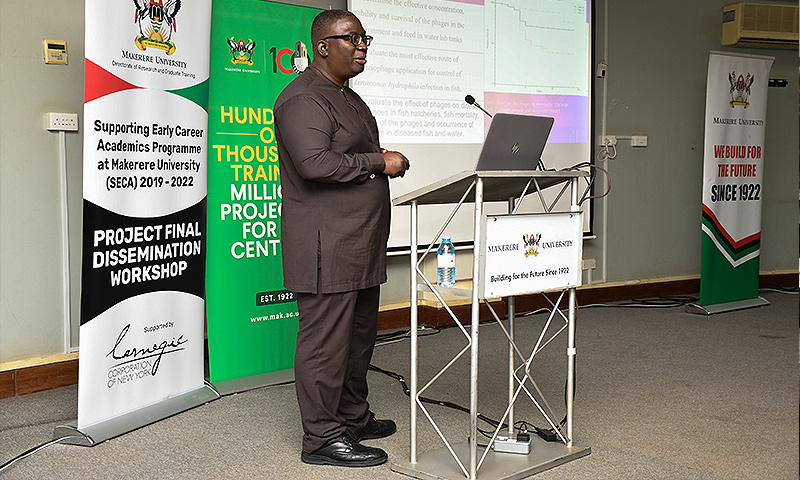
He added that this architecture enabled the SECA team to build synergies between the different levels of research development and in so doing, ensure sustainability by institutionalizing mentorship. Prof. Buyinza therefore encouraged the fellows to continue posting their successes on the SECA portal and holding the lunchtime seminars in their departments.
“I want to believe that your skills have been enhanced, your vision to research has been touched beyond publishing an article to looking at the wider spectra of events that form you as a regional research leader. We want you to form a regional network so that together you can write research grants, supervise graduate students and influence the research agenda in the different countries” concluded Prof. Buyinza.
Details of the fellows and their research projects may be viewed in the table below.
| No. | Name | Unit | Project Title |
| 1. | Dr. Dhabangi Aggrey | Child Health and Development Centre (CHDC), CHS. | Hemolytic Disease of the New-born in Uganda: Burden and Clinical Characteristics |
| 2. | Dr. Edopu Nabuyungo Ritah | Department of Fine Art, MTSIFA, CEDAT. | Community Product Design Education for Improved Market Access. |
| 3. | Dr. Kabagenyi Allen | Department of Population Studies, CoBAMS. | Adolescent Motherhood, pre and postnatal New-born care practices, perceptions and barriers in Eastern Uganda (AMNEP). |
| 4. | Dr. Kambugu Robert | Department of Agricultural and Biosystems Engineering, CAES | Modeling of long-term development scenarios for plantation forestry and forest industries in Uganda. |
| 5. | Dr. Kavuma Namirembe Susan | Department of Policy and Development Economics, CoBAMS | Empirical Evaluation of Spatial Connectivity, Urban structure, Density and Firm Productivity: Evidence from Kampala. |
| 6. | Dr. Kindi Immanuel Fredrick | School of Women and Gender Studies, CHUSS. | Gender, Oil and Migration in the Albertine Graben Region, Uganda. |
| 7. | Dr. Mayanja Nanziri Maureen | Department of Bio-security, Ecosystem and Veterinary Public Health, CoVAB. | Ethnoveterinary Medicinal Plant Technology Information Pathways and Prospective for Sustained Usage among Transhumant Pastrolists in Karamoja. |
| 8. | Dr. Muhanguzi Denis | Department of Bio-molecular and Bio-Laboratory Sciences, CoVAB | Targeting hotspot villages to accelerate the eradication of Acute Sleeping Sickness (ASS) from Uganda. |
| 9. | Dr. Mwesigye Rutabatiina Abraham | Department of Forestry, Biodiversity and Tourism, CAES. | Epidemiological survey of populations exposed to heavy metals and trace elements from Mining activites in Uganda. A case study of Kilembe copper mine catchment. |
| 10. | Dr. Mwikirize Cosmas | Department of Electrical and Computer Engineering, School of Engineering, CEDAT. | Efficacy of Deep Learning-aided Platform for Diagnosis of Breast Cancer using Ultrasound Images in the Ugandan Population. |
| 11. | Dr. Najjemba Harriet P. | Institute of Open Distance and E-learning, CEES. | Using Emerging Technologies to Capture and Disseminate Indigenous Agricultural Practices for Improved Food Production in Uganda: A case of Luweero District (INDIGRIC). |
| 12. | Dr. Nambi Rebecca | Department of Humanities and Language Education, CEES. | Supporting refugee access and participation in higher education: A case of Makerere University. |
| 13. | Dr. Nasirumbi B. Losira | School of Agricultural Sciences, CAES. | Intra-household gender dynamics and uptake of agricultural technologies for sustainable livelihoods in Uganda. |
| 14. | Dr. Semujju Brian | Department of Journalism and Communication, CHUSS. | Evaluating Digital Literacy to Create a Policy for Digital Media use at Makerere University. |
| 15. | Dr. Ssekuubwa Enock | Department of Forestry, Biodiversity and Tourism, CAES. | Enhancing the use of Farmer-Managed Natural Regeneration for mitigating climate change, conserving biodiversity and improving livelihoods in Uganda’s Cattle Corridor (FMNR). |
| 16. | Dr. Tamale Andrew | Department of Wildlife and Aquatic Animal Resources, CoVAB. | Operationalization of Phages for Management of Bacterial Diseases in Fish Hatcheries |
| 17. | Dr. Zawedde Aminah | Ministry of ICT and National Guidance. Formerly CoCIS. | QATE: A Public Participatory Approach for Quality Assessment of e-Government Services to Enable Sustainable Development. |
You may like
-
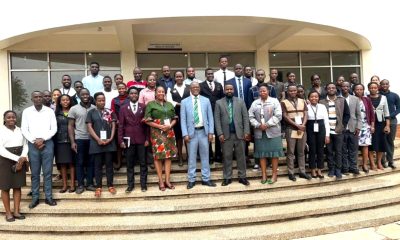

Mak Moves to Revitalize Food Technology & Business Incubation Centre to Drive Innovation & Entrepreneurship
-
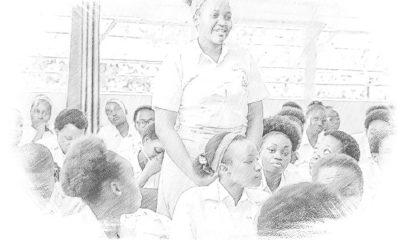

Ugandan Study Flags Girls and Senior Students as a Mental Health High-Risk Group
-


Makerere’s PIM Centre Concludes Training on Certificate of Financial Implications (CFI)
-
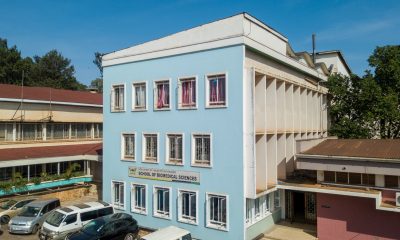

Call for Applications: Responsible Conduct of Research (RCR) Training Course
-
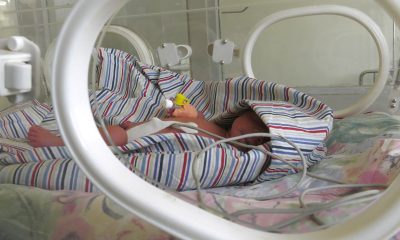

Call For Applications: PhD Fellowship Training Position
-


Makerere Hailed for Its Leadership in Health Policy and Knowledge Systems
Health
Ugandan Study Flags Girls and Senior Students as a Mental Health High-Risk Group
Published
2 days agoon
July 12, 2025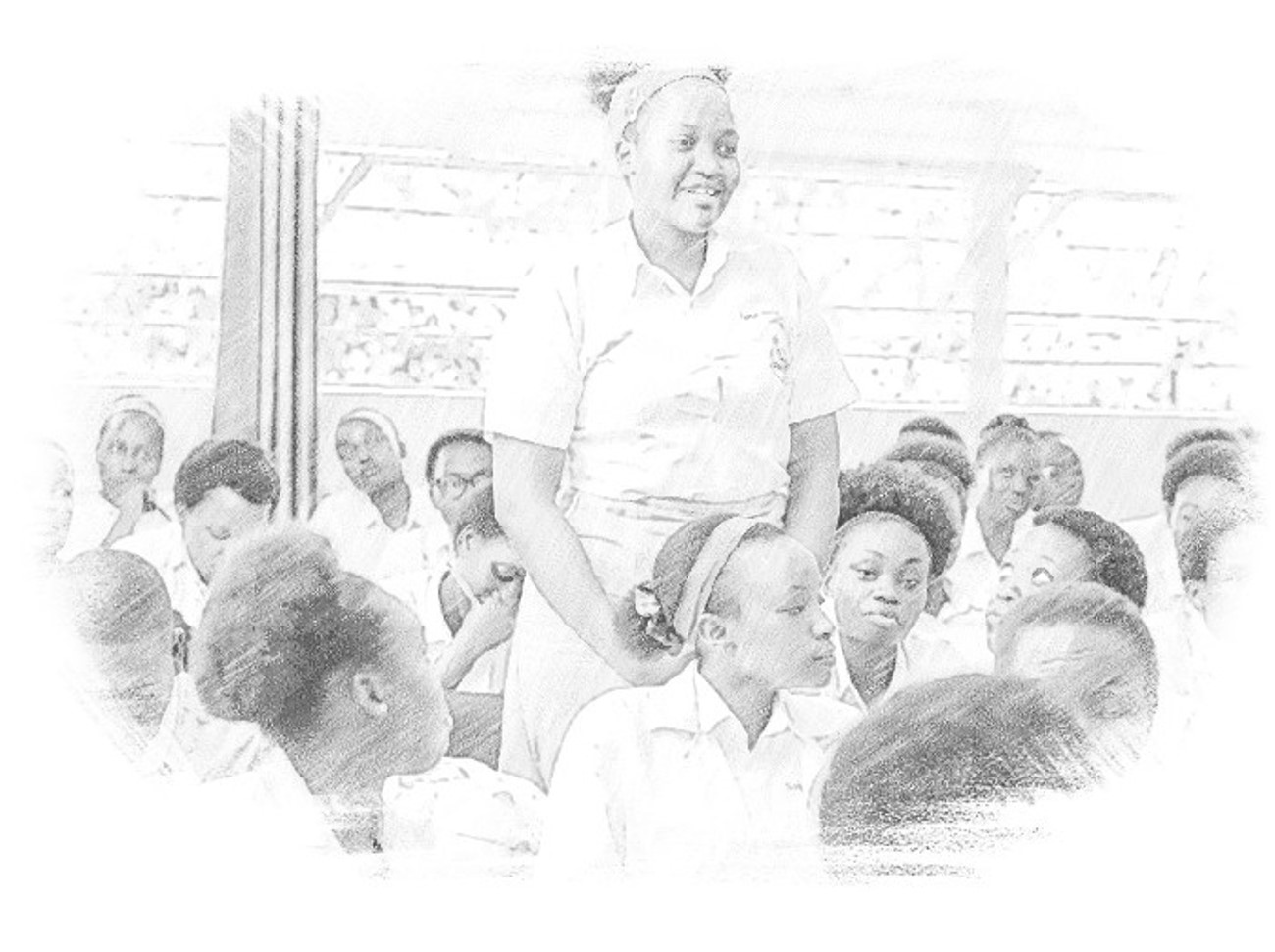
Based on research led by Max Bobholz and colleagues from Makerere University in Uganda, Essentia Institute of Rural Health, and the Medical College of Wisconsin in the United States.
Adolescence is meant to be a time of holistic growth and self-discovery, but for many Ugandan teenagers, this period is becoming a season of silent mental health struggles. A new study published in PLOS Global Public Health has uncovered a silent but growing crisis: nearly one in five Ugandan secondary school students in the study areas have signs of an emotional disorder. These conditions included anxiety, depression, post-traumatic stress disorder (PTSD), and adjustment disorders often involving excessive worry, sadness, fear, or mood instability. Also, one in 20 adolescents exhibited behavioral issues ranging from attention-deficit/hyperactivity disorder (ADHD) and oppositional defiant disorder to substance use and other risky behaviors like alcohol use.
The study, led by Max Bobholz, a PhD candidate in Public and Community Health at the Medical College of Wisconsin, surveyed a sample of 1,953 students aged 10 to 18 years enrolled in eight secondary schools in Iganga district in Eastern Uganda and Mukono district in Central Uganda. This was one of the most comprehensive efforts yet to understand the prevalence and drivers of mental health challenges among school-going Ugandan adolescents.
“We are looking at a generation facing a complex blend of stressors, namely, academic, social, and emotional,” says Bobholz. “Our findings show that certain groups are especially vulnerable, and schools need to be equipped to respond.”
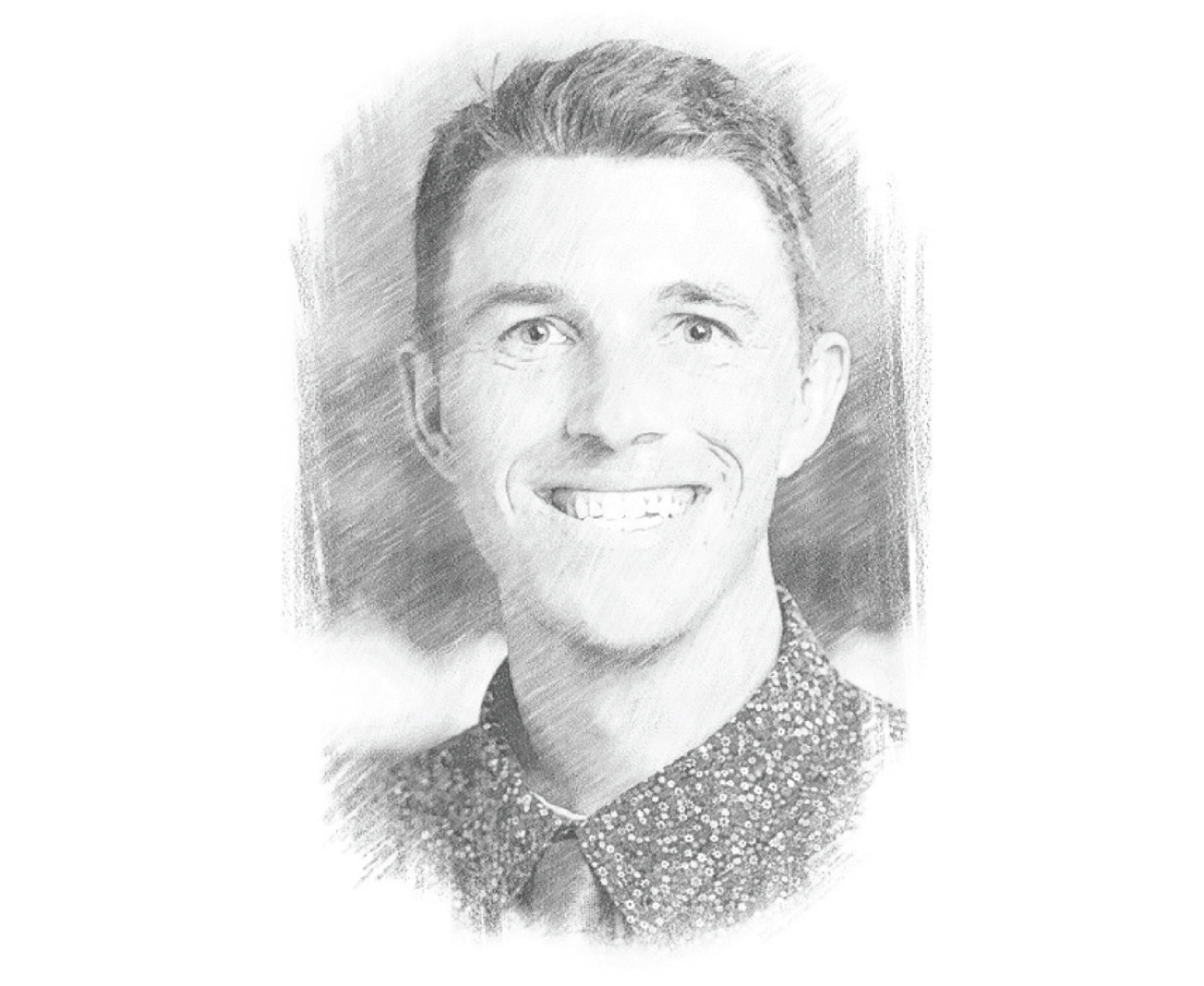
This study results, published on June 12, 2025 was funded by the Swedish International Development Cooperation Agency (SIDA), a government agency of the Swedish Ministry for Foreign Affairs, through the Makerere University Postdoctoral Fellowship to one of the investigators, Dr. Catherine Abbo. Other researchers included Julia Dickson-Gomez, Arthur Kiconco, Abdul R. Shour, Simon Kasasa, Laura D. Cassidy, and Ronald Anguzu.
According to the study, girls bear a higher emotional burden. Researchers found that female students had nearly two times higher odds of suffering from emotional disorders such as anxiety or depression than their male peers.
Dr. Catherine Abbo, an Adolescent Psychiatrist and Associate Professor at Makerere University, attributes this to both biological and socio-cultural factors. “Puberty brings hormonal shifts that can heighten emotional sensitivity,” she explains. “But just as importantly, Ugandan girls often face intense pressure to conform to gender roles while also navigating issues like body image, harassment, and future uncertainty.” The researchers are calling for gender-sensitive mental health interventions, particularly in schools, where early support could help mitigate long-term mental health issues.
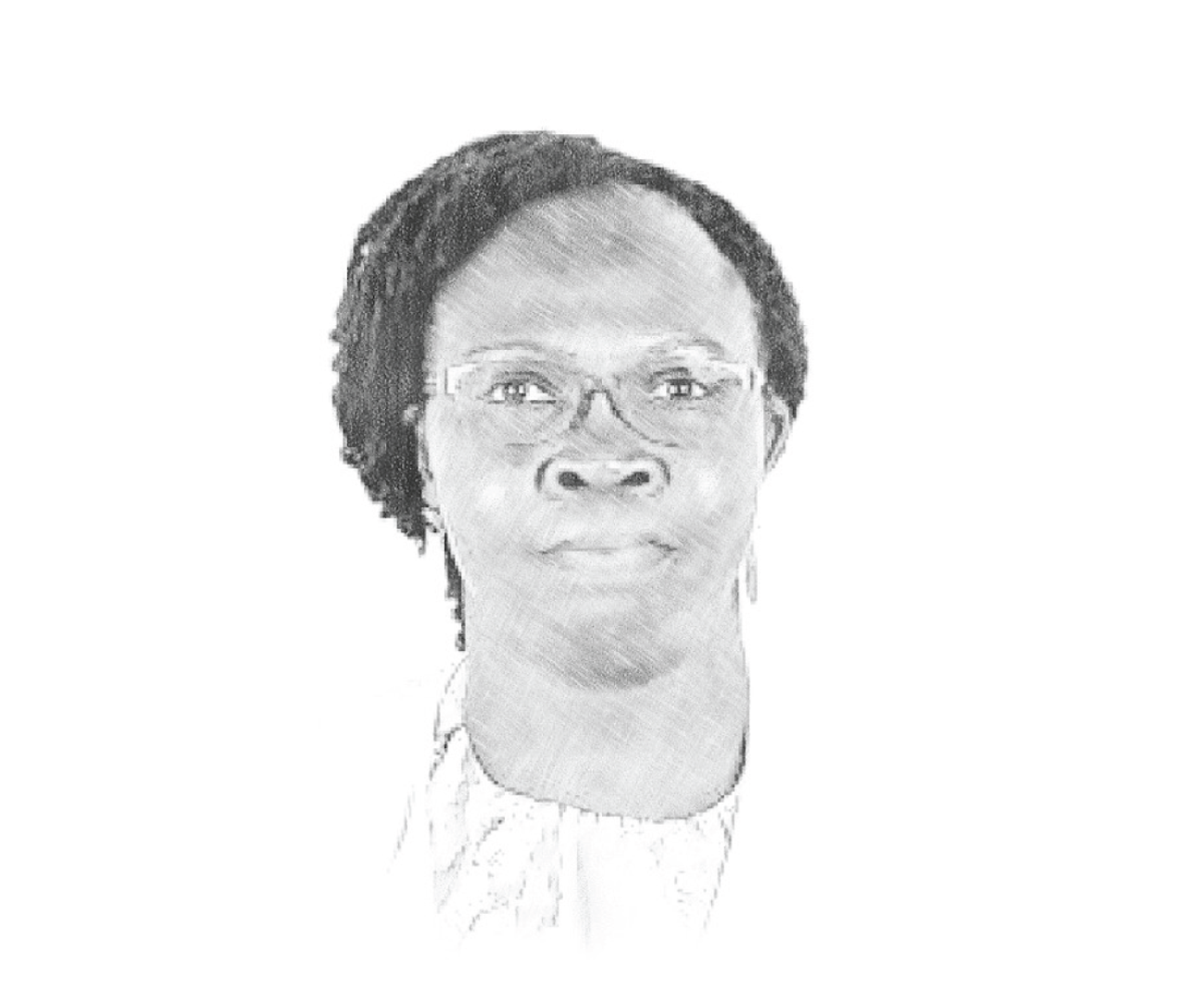
Higher associations in older teens?
Age also emerged as a key associated factor, with each additional year increasing the odds of behavioral disorders by 20%. “As adolescents grow older, they are more prone to risk-taking, impulsivity, and resistance to authority,” explains Dr. Simon Kasasa, a senior lecturer and biostatistician at Makerere University School of Public Health.
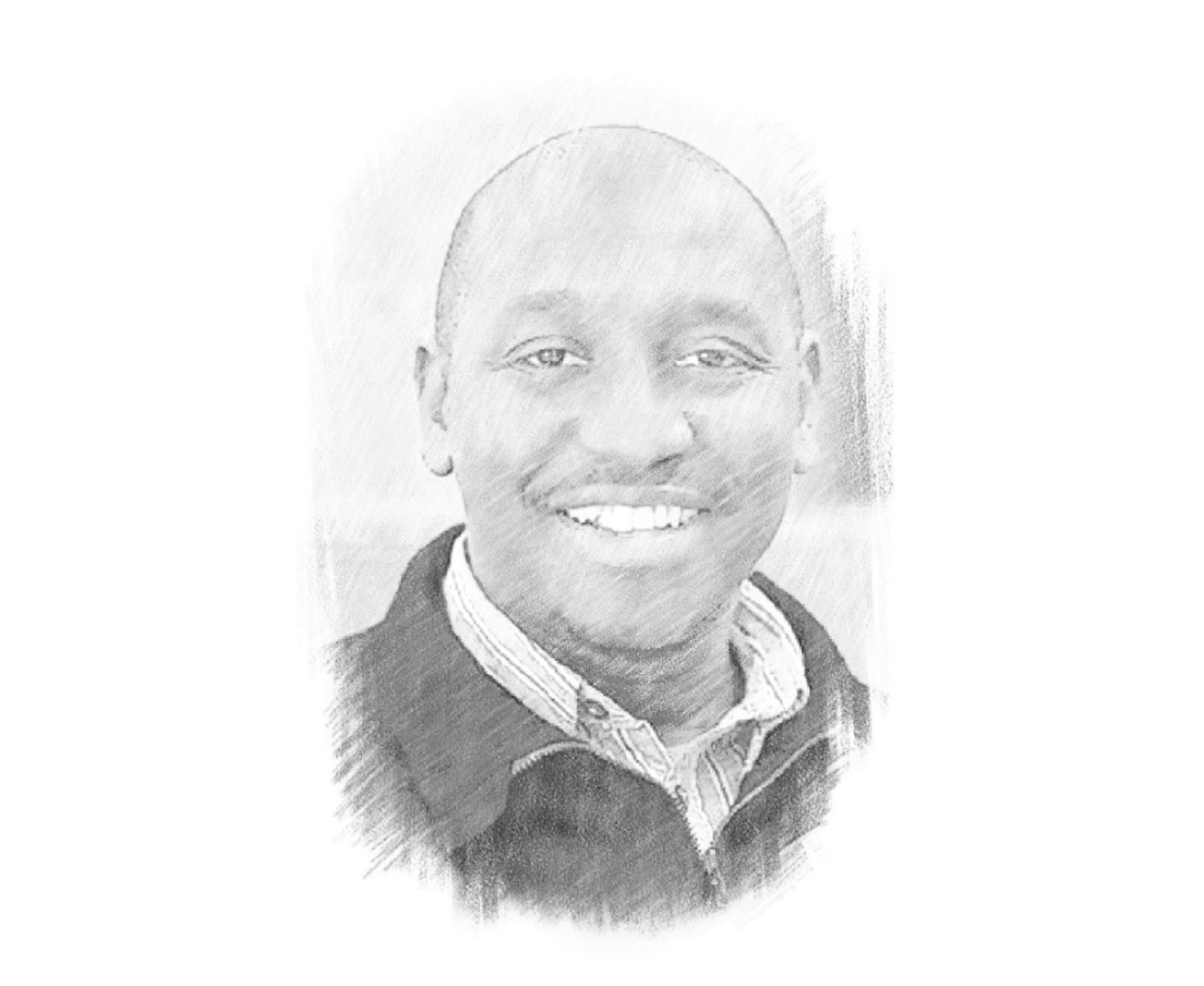
“Combine that with academic pressure and identity-related stress, and it’s no surprise we’re seeing more conduct issues in late adolescence,” Dr. Ronald Anguzu, an Assistant Professor in the Institute for Health and Humanity at the Medical College of Wisconsin, added. This study raises critical questions about whether and how Ugandan secondary schools support older students as they transition toward adulthood.
The unseen influence of family mental health
The study also found that adolescents with a family history of mental illness had twice the odds of exhibiting behavioral problems compared to those without such a history.
“This speaks to the intersection of genetics and environment,” says Bobholz. “Living in a household with people affected by mental illness can mean instability, stigma, and lack of emotional support, all of which weigh heavily on a developing mind.”
The authors recommend that school mental health screening include family mental health history and advocate for greater collaboration between education and health sectors to support at-risk households.
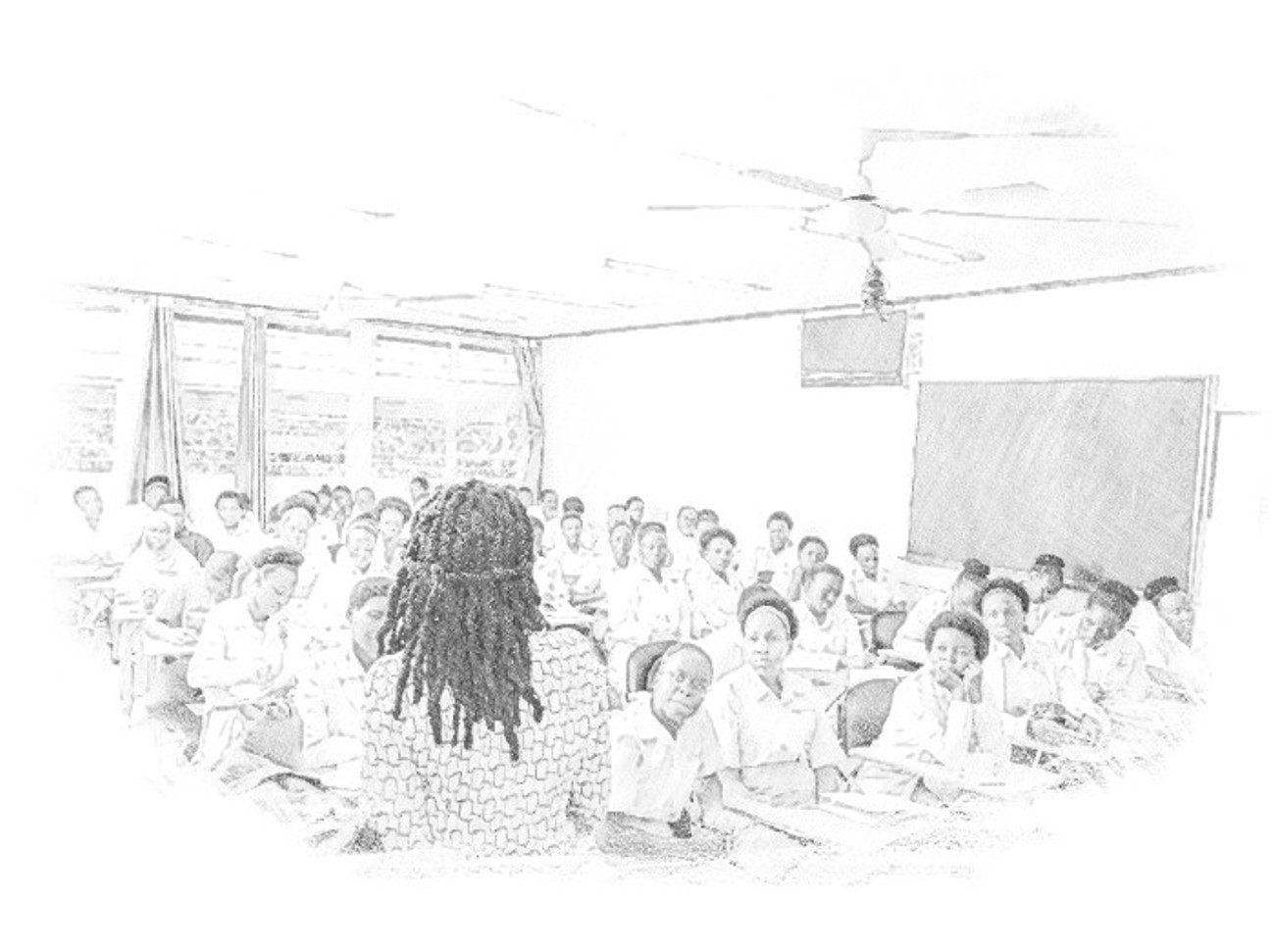
Private schools: High marks, higher stress?
Interestingly, students in private schools had 1.4 times the odds of experiencing emotional disorders compared to those in public schools. Private schools, often seen as academic havens, may inadvertently be cultivating high-pressure environments. “There’s an assumption that better facilities mean better well-being,” says Dr. Abbo. “But intense academic competition, social isolation, and a lack of trained counselors can create emotional pressure cookers.”
Previous research in 47 secondary schools across five districts (Rakai, Kyotera, Masaka, Lwengo, and Kalungu) in southwestern Uganda found that economic and family support helped reduce absenteeism among adolescent girls in secondary schools. However, this support did not significantly improve behavior or reduce grade repetition. The region, which includes districts like Rakai and Masaka, also faces a higher burden of HIV, adding to the challenges young people experience.
Meanwhile, a review of data from 42 primary schools in Luwero District identified school-based mental health interventions such as cognitive behavioral therapy and mindset-building approaches as being particularly effective. Researchers now suggest that integrating these strategies, along with efforts to reduce school violence, could go a long way in improving the mental health of Ugandan adolescents.
A-Level pressure: Academic ambition meets mental health strain
The study also found a correlation between advanced (A’level) education and increased risk of emotional disorders. “We selected one school district from each region based on population and past academic performance. As these students prepare for university or the job market, the pressure to succeed becomes enormous,” says Kasasa. “They’re facing a future full of uncertainty, with very little structured mental health support to help them cope.”
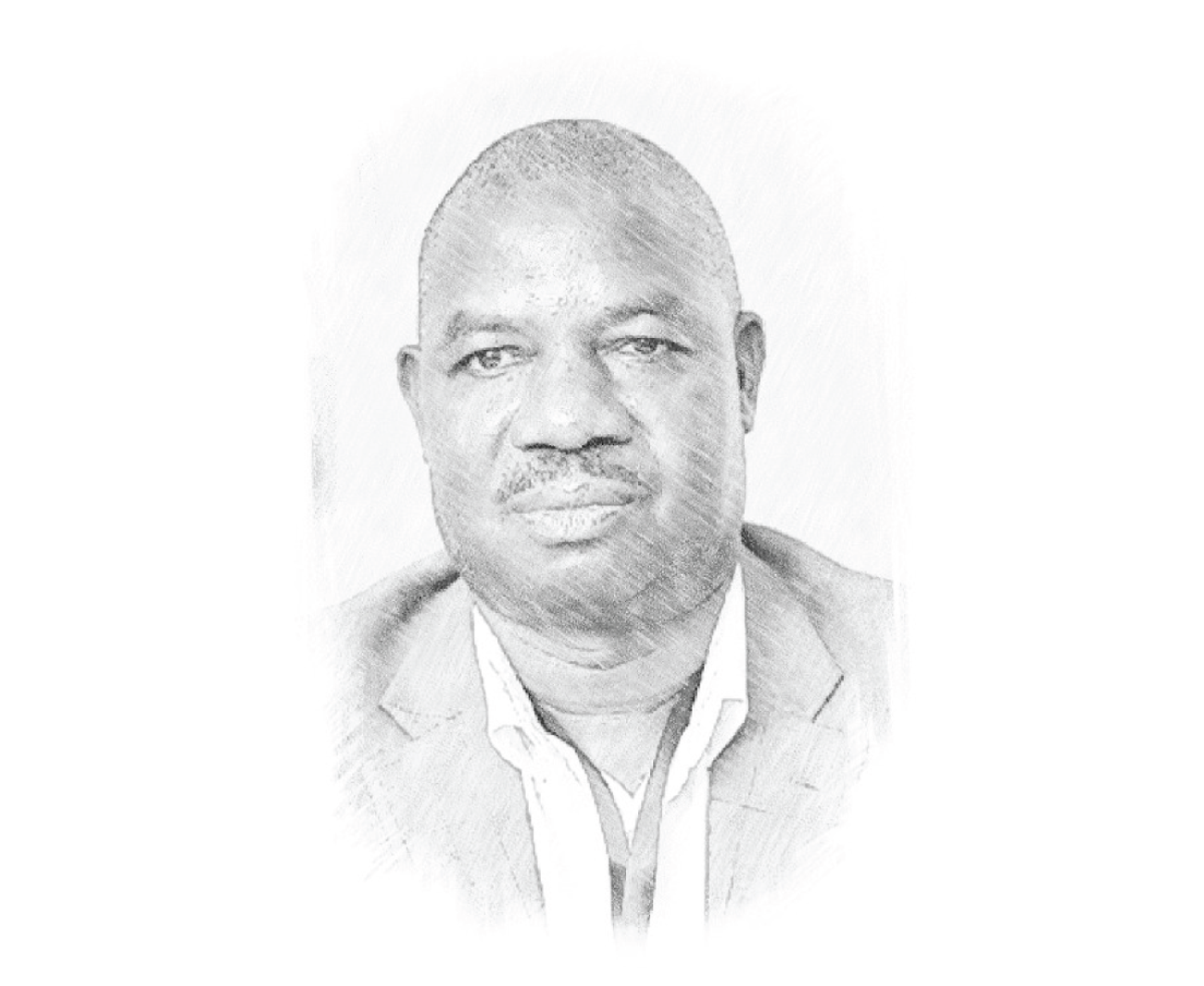
A wake-up call for Uganda’s education and health systems
The authors of this study assert the urgent need for school-based mental health programs, especially in private and A-level institutions. These programs should offer routine screening, emotional support, and training for teachers to recognize warning signs of mental health disorders.
Importantly, this study adds weight to calls for a national adolescent mental health policy, tailored to Uganda’s context, with interventions that bridge health, education, and social services.
“Our data shows that mental health challenges are not a fringe issue,” says Bobholz. “They are widespread, significant, and deeply tied to school, home, and society.”
The COVID-19 school closures between 2020 and 2022 deepened feelings of isolation and financial strain, with out-of-school adolescents reporting depression rates as high as 21.5% to 50% higher than their peers who remained in class, according to research published in February 2025. Yet Uganda invests less than 1% of its health budget in mental health, with just one psychiatrist per million people, leaving many teens to cope through cheap alcohol used by 28% of urban youth or untrained healers, as reported by the government paper The New Vision in April 2025. With only 26% of students completing lower secondary school and 35% of the population under age 24, these mental health challenges now pose a serious threat to the country’s future.
Mercy Akankunda of Proven Foundation, a Ugandan NGO supporting vulnerable groups, warns that mental health struggles are quietly eroding the well-being of the country’s youth, over 12 million strong and making up 35% of the population. “These teens are not just statistics. They are the future of Uganda, she asserts. If Uganda hopes to reap the dividends of its young population, addressing adolescent mental health must become and remain a national priority, not just for treatment, but for prevention, resilience, and hope.
Reference:
Bobholz, M., Dickson-Gomez, J., Abbo, C., Kiconco, A., Shour, A.R., Kasasa, S., Cassidy, L.D., & Anguzu, R. (2025). Correlates of behavioral and emotional disorders among school-going adolescents in Uganda. PLOS Global Public Health. Read the study here
Health
Call For Applications: PhD Fellowship Training Position
Published
4 days agoon
July 10, 2025By
Mak Editor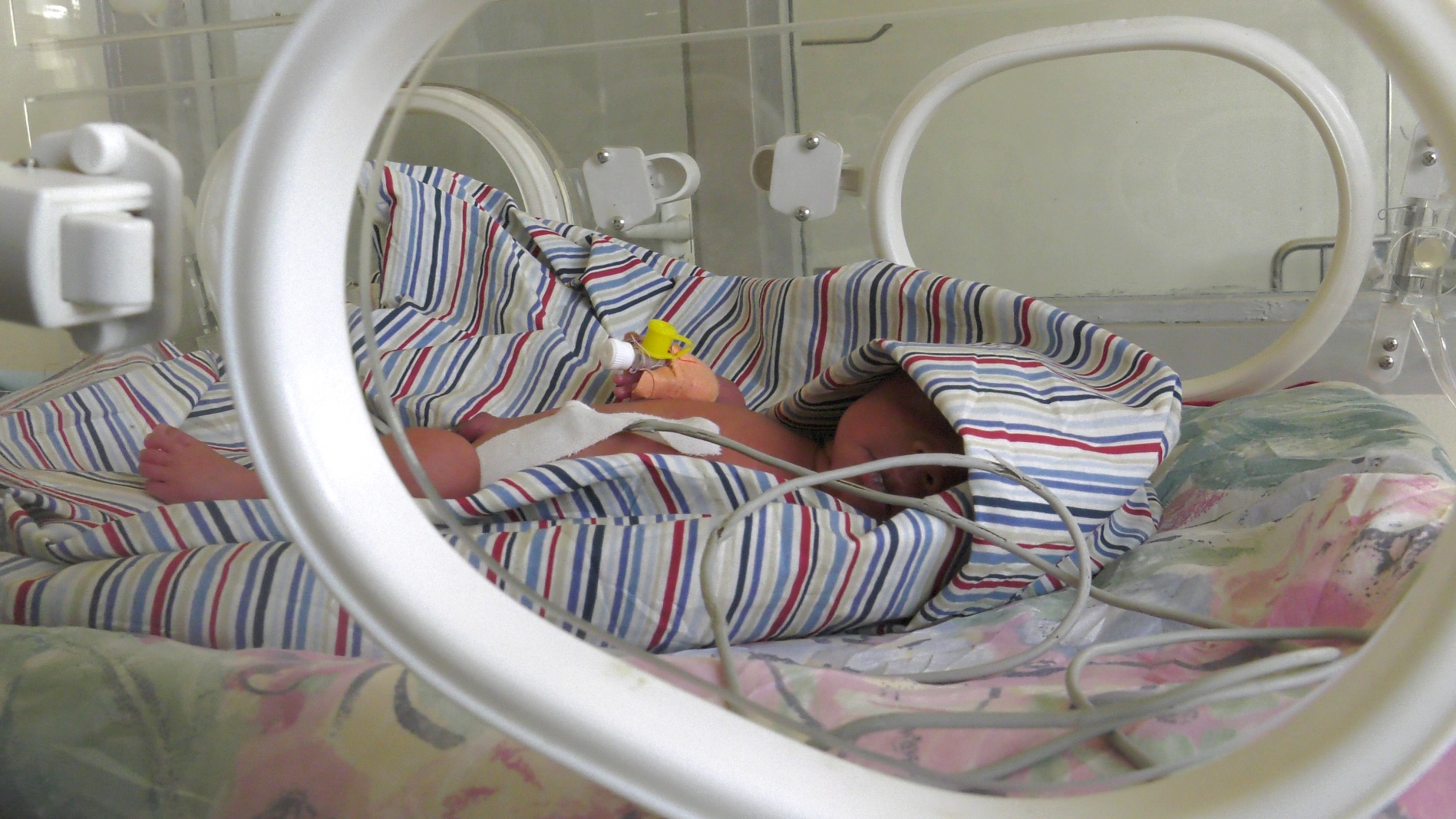
Background:
Makerere University College of Health Sciences (MakCHS), Kampala, Uganda and Global Health Uganda (GHU); in collaboration with other research consortium partner institutions, including, Kenya Medical Research Institute (KEMRI), Kisumu, Kenya; Training and Research Unit of Excellence (TRUE), Blantyre, Malawi; University of Bergen, Bergen, Norway; University of Amsterdam, The Netherlands; and Liverpool School of Tropical Medicine (LSTM), UK have been conducting clinical research on Malaria Chemoprevention. This research has focused on Malaria Chemoprevention in vulnerable patient populations, including children with severe anaemia, children with sickle cell anaemia and pregnant women. As an example, two of our recently completed studies are “The post-discharge malaria chemoprevention in children with severe anaemia [https://pubmed.ncbi.nlm.nih.gov/33264546/] and Malaria chemoprevention in children with sickle cell anaemia [https://pubmed.ncbi.nlm.nih.gov/39718172/]”.
With support from the UK Research and Innovation (UKRI) body, the consortium is expanding these studies to children with severe acute malnutrition, by conducting a large multi-centre randomized controlled trial entitled “Chemoprevention of malaria in the postdischarge management of children with severe acute malnutrition in Malawi and Uganda”.
In Uganda, the study will be conducted at one or two of their study sites in Jinja Regional Referral Hospital, Hoima Regional Referral Hospital or Kitgum General Hospital. Makerere University College of Health Sciences (MakCHS) and Uganda and Global Health Uganda (GHU) seek to appoint a full-time PhD Fellow, on this study. This will be a 4-year post, tenured at Makerere University and hosted at MakCHS.
Expectations of the PhD fellowship:
The PhD fellow will:
- Be a part of the main trial team, and participate fully in its implementation. However, he/she will be expected to design and develop his/her PhD research project, nested in the main trial.
- The area of study will be around “interactions between anaemia and severe acute malnutrition (SAM) in children or the interactions between malaria and severe acute malnutrition in children”.
- Conduct rigorous research, leading to high quality scientific publications.
- Submit a full research concept and obtain registration in the University by end of year-one. As such, there be an initial appointment for one year, renewable upon satisfactory performance.
- Academic mentorship and supervision will be provided by the research consortium (see above – composed of national and international researchers).
- Doctoral scholarly support and training environment, as well as didactic training in research methods and scientific writing skills will be provided by Makerere University.
- The funding support will cover tuition and a competitive monthly stipend for 4 years, scientific conferences fees/travel and other research-related costs.
Prospective candidates must:
- Hold Master’s of Medicine in Paediatrics and Child Health from a recognized university, and licensed to practice medicine in Uganda by the UMDPC.
- Possess undergraduate training in Medicine and Surgery (MBChB/MBBS/MD).
- Willingness to fully commit time and effort to their PhD studies, expected to start immediately
- Candidate should not hold other/concurrent fellowships
- Having publication experience will be an added advantage.
- Be highly motivated and willing to commit to a career in research and academia.
Application procedure:
Interested applicants should submit their application and supportive documents – listed here below, in one PDF document, in an email titled “PDMC-SAM–PhD Fellowship Application” to hr@globalhealthuganda.org [and cc – chdc.desk@mak.ac.ug] by 25th July 2025. The documents should include the following:
- An application letter (Max. 1 page)
- Motivation statement (Max. 500 words)
- CV (Max. 2 pages), including a list of publications
- Two (2) recommendation letters
- Academic transcripts and certificates for all university qualifications
- A synopsis focusing on the proposed PhD research work, describing briefly what is already known/burden, challenges, the gaps and potential interventions (include references) [Max. 800 words].
General
Directorate of Graduate Training concludes 9-day Phd Cross Cutting Training
Published
2 weeks agoon
July 4, 2025By
Mak Editor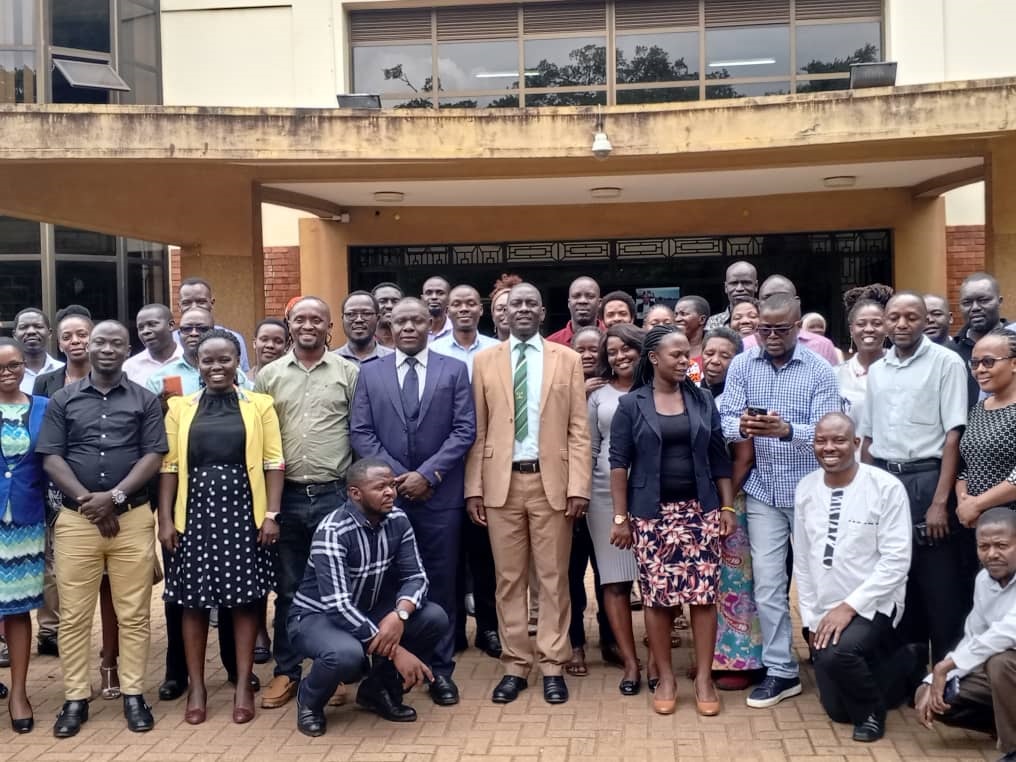
By: Moses Lutaaya
The Directorate of Graduate Training has completed a 9- day PhD crosscutting training course, inducting three groups of PhD students. The groups of students included those in Cohort 1, Cohort 2 and the Non Cohort PhD students. The number of PhD student participants were over 300 students learning via both face to face and online.
The training that started on Monday 2nd June 2025, took place in the New Library Building.
In his closing remarks, the Director of Graduate Training Prof. Julius Kikooma encouraged the PhD students to put up a spirited fight that would see them remain in the cohort up to the end of the three years of their doctoral studies.
“Get organized, show seriousness in your doctoral pursuit, stay together, make use of your supervisors as and when you need them. We will fully support you in your Doctoral academic journey.” Prof. Kikooma said.
Prof. Kikooma emphasized the need for PhD graduate training saying, “We need more research for the University and Country. This cannot be achieved without increasing the number of graduate students especially PhDs.”
At their different stages of PhD doctoral training, Prof. Kikooma encouraged the students to give feedback to the Directorate and the supervisors so that they are served seamlessly.
Prof. Kikooma further informed the students that going forward, they must cover all the three mandatory cross cutting courses meant to be taught under the three-year program of their doctoral studies.
“All three foundation courses including Scholarly Writing, Advanced Research Methods and Philosophy of Methods will be covered. Tighten your belts. We want to ensure that all these structured programs prepare you for the foundations you need for next two years of research. Success becomes easy when you undertake foundations.”
He challenged the students to use the program in guiding their research directions, making informed decision, improving their critical thinking and consumption of knowledge.
Dr. Dixon Knanakulya, one of the trainers of the doctoral students said, “At PhD level, it is no longer a normal research. It is at a level of knowledge production. The students must understand the main philosophical assumption behind the research methods they use and they must consider the ethical implications of their research. Philosophy of Methods enables them to go through that.”
“PhD students must be creative, innovative and start at the level of researching in the mind. This challenges them to think differently.” He added.
He further said that Philosophy of Methods helps in researches done at the different aspects of the national development plan. “Usually, the students question how the National plans are come up with and support improvement of government policies.”
Dr. Kanakulya added that the research output can be used by government for improvement because it is done by highly skilled researchers. Adding, “They come with very good insights which can be taken on to improve implementation of government programs such as Emyoga and Parish Development Model (PDM).”
He further said that policies are not enough without the social conditions and mindset of the people, saying that PhD scholars can help government know the social conditions and apply policies better.
The Cohort 1 PhD students’ president Mr. Wanyakoko Ebiru Moses said, “This training is extremely important for each student under taking doctoral studies and without it, they cannot acquire the fundamental skills they need to become independent researchers.”
He added that with the knowledge acquired in the Philosophy of Methods training, they will focus on research that aims to resolve societal and community problems.
Dr. Robert Kakuru, the President of Makerere University Academic Staff Association said that Philosophy of Methods is an important pillar in the doctoral journey of every PhD student.
“The Course, Philosophy of Method provides a critical foundation and Philosophical grounding for research methods that doctoral students use to undertake their respective studies. The course further underlines other critical issues that graduate students ought to know, integrate, adopt or adapt in their doctoral journeys.” He said.
Dr. Jim Spire Ssentongo, a senior lecturer and coordinator of the training said, “Philosophy of Methods builds a mass of critical researchers who are able to look at the world not from a narrow point of view but a holistic and broad based sense of understanding reality.”
He added, “Students understand how they can imagine the world to be. They take into account assumptions which inform the methods of research used, how they conduct themselves during research and how they approach respondents during the research process. Such assumptions are laid bear in this training and it helps participants to understand the things they have always held at the back of their minds without deliberately knowing that these are the assumptions they hold and this is how they affect and influence studies.”
Dr. Ssentongo further said that once PhD students are engaged in reality in its broadness with right assumptions, they are then better placed as researchers to investigate such realities and that whatever they investigate, be it related to the National Development Plan and National Development Initiatives like Emyoga and Parish Development Model. This training positions, them at a more critical level as researchers not only in terms of assumptions but also being thinkers.
The Philosophy of Methods training was supported by the ICARTA – Institutionalization of Advanced Research Training in Africa, a NORHED II Project at Makerere University.
Trending
-

 Education1 week ago
Education1 week agoAdmission List to Bachelor of Education External (BED) 2025/26 -Private Sponsorship
-
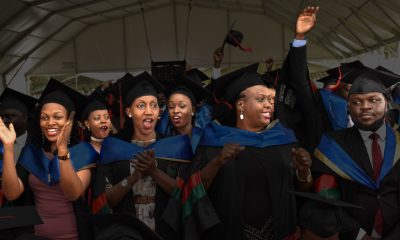
 General2 weeks ago
General2 weeks agoUndergraduate Admission List Self Sponsorship Scheme 2025/2026
-
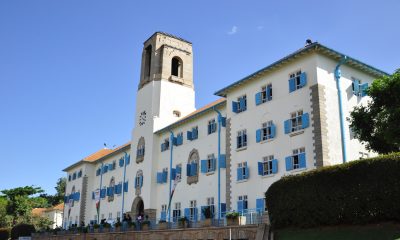
 General6 days ago
General6 days agoRe-advert: Admission to Undergraduate Programmes 2025/2026
-
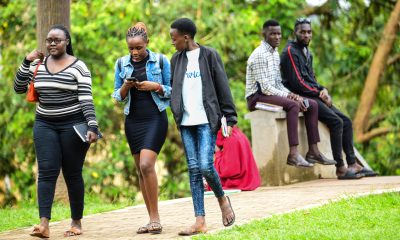
 General2 weeks ago
General2 weeks agoAdmission Lists -Disability and District Quota Schemes 2025/26
-
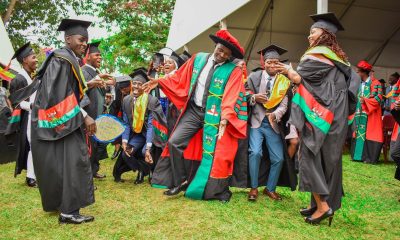
 General2 weeks ago
General2 weeks agoDiploma/Degree Holders Scheme – Self Sponsorship Admission Lists 2025/26
